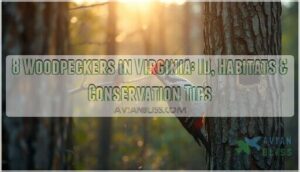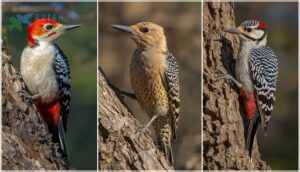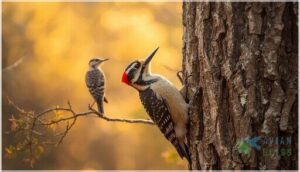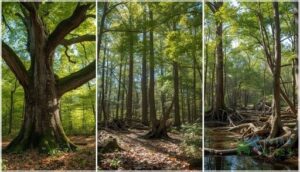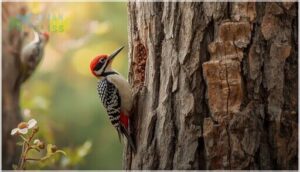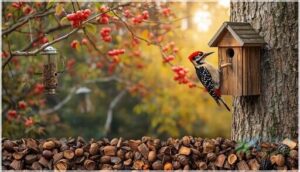This site is supported by our readers. We may earn a commission, at no cost to you, if you purchase through links.
You’re probably familiar with the staccato drumming that echoes through Virginia’s forests on crisp mornings, but you might be surprised to learn that eight distinct woodpecker species call the state home. These exceptional birds range from the sparrow-sized Downy Woodpecker tapping at backyard feeders to the crow-sized Pileated Woodpecker carving rectangular cavities in mature hardwoods.
Each species has carved out its own ecological niche across Virginia’s diverse landscapes—from the coastal plain to the Blue Ridge Mountains—adapting their foraging techniques, nesting preferences, and habitat requirements to thrive in different conditions.
Understanding how to identify these species and recognize their unique behaviors will transform your next woodland walk into an opportunity to witness some of nature’s most specialized architects at work.
Table Of Contents
- Key Takeaways
- Types of Woodpeckers in Virginia
- Identification and Physical Characteristics
- Woodpecker Habitats Across Virginia
- Woodpecker Behavior and Feeding Habits
- Conservation and Attracting Woodpeckers
- Frequently Asked Questions (FAQs)
- What is the most common woodpecker in Virginia?
- Is it good to have woodpeckers in your yard?
- What does it mean if a woodpecker is pecking my house?
- What attracts woodpeckers to your house?
- What sounds do Virginia woodpeckers make?
- How do Virginia woodpeckers impact trees?
- Why do woodpeckers tap on houses?
- What are signs of woodpeckers in an area?
- How can I deter woodpeckers humanely?
- What time of year do woodpeckers migrate?
- Conclusion
Key Takeaways
- Virginia hosts eight distinct woodpecker species ranging from the sparrow-sized Downy to the crow-sized Pileated, each occupying specialized ecological niches across habitats from coastal plains to mountain forests.
- The Red-cockaded Woodpecker represents Virginia’s greatest conservation success story, rebounding from just two breeding pairs in 2000 to 18 groups by 2025 through targeted habitat restoration and prescribed burning in southeastern pine savannas.
- Woodpeckers function as ecosystem engineers by excavating cavities that subsequently shelter over 40 bird species while providing essential pest control by consuming wood-boring beetles and invasive insects throughout Virginia’s forests.
- You can support woodpecker populations by preserving standing dead trees (snags) for nesting, providing suet feeders and elevated birdbaths, and maintaining diverse forest age classes with native oak, hickory, and birch species.
Types of Woodpeckers in Virginia
Virginia’s diverse woodlands support eight distinct woodpecker species, each with unique characteristics and habitat preferences.
You’ll find everything from the tiny Downy Woodpecker visiting your backyard feeder to the crow-sized Pileated Woodpecker deep in mature forests.
Let’s explore each species you’re likely to encounter across the state.
Downy Woodpecker
You’ll spot the Downy Woodpecker—North America’s smallest woodpecker—on about 1 in 5 birdwatching trips across Virginia. Males display a distinctive red patch on their caps, and their black-and-white plumage provides excellent woodpecker camouflage against tree bark.
These year-round residents excavate tree cavities in dead snags for nesting behavior, preferring sites 8 to 50 feet high. Unlike some woodpecker species, they show minimal woodpecker migration patterns.
The Downy Woodpecker’s ability to thrive in various habitats is due to its unique woodpecker feeding habits.
Hairy Woodpecker
While Downies charm you with their compact size, the Hairy Woodpecker brings a bold presence to Virginia’s forests. This common resident stays year-round, showing minimal woodpecker migration. You’ll identify it by:
- Length of 7-10 inches with striking black-and-white plumage
- Long chisel-like bill for deep bark excavation
- Large white back patches distinguishing it from smaller relatives
- Males sporting small red head patches
- Territory sizes spanning 2.4-15 hectares in mature woodlands
Its role in forest ecology and bird conservation centers on controlling wood-boring beetles—critical for wildlife management and Virginia’s woodland health. The Hairy Woodpecker’s habitat preferences are closely tied to mature forest ecosystems.
Red-bellied Woodpecker
Unlike its Hairy cousin, the Red-bellied Woodpecker thrives in Virginia’s deciduous forests and suburbs year-round, showing little woodpecker migration. You’ll identify this common resident by its zebra-striped back and the red head gender difference—males wear full red caps while females show red only on the nape. Despite its name, that belly blush is faint.
Its omnivorous red belly diet includes insects, nuts, and fruits stored in bark crevices. Tree cavity nests house family groups showing minimal woodpecker social behavior beyond breeding season.
Northern Flicker
You’ll recognize the Northern Flicker by its brown, spotted body and yellow wing flashes—a ground-foraging specialist in Virginia’s open woodlands.
With approximately 202,000 individuals statewide, this widespread species shows modest migration patterns and surprising sociality, gathering in winter groups of twelve.
Males excavate nesting cavities 6–20 feet high, facing competition from starlings. Their ant-heavy diet and flicker longevity, averaging several years, make them essential for Virginia wildlife health.
Pileated Woodpecker
The Pileated Woodpecker stands as Virginia’s largest woodpecker species, reaching 19 inches—nearly crow-sized. You’ll identify this striking bird by its black body, white face stripes, and vivid red crest.
In Virginia wildlife research, forest ecology studies show it needs mature forests with abundant dead wood for nesting and foraging. With 2.6 million individuals across North America, woodland management efforts maintain stable populations through habitat protection.
Red-cockaded Woodpecker
Virginia’s rarest treasure, the Red-cockaded Woodpecker, clings to survival in the state’s far southeastern pine savannas. You’ll spot this endangered species by its striking black-and-white plumage and distinctive white cheek patches.
Woodpecker conservation efforts have achieved outstanding species recovery through habitat restoration:
- Population rebound: 18 breeding groups now thrive after collaborative conservation efforts
- Critical habitat: Fire-maintained pine savannas at Piney Grove Preserve and Big Woods WMA
- Cooperative breeding: Helper birds assist with raising young in family groups
- Cavity marking: Flowing sap around nesting sites signals territory boundaries
- Specialized diet: Ants, beetles, and wood-boring insects from mature pines
Red-cockaded woodpeckers represent Virginia’s northern population edge, making local protection essential for this species’ survival.
Red-headed Woodpecker
You’ll recognize the Red-headed Woodpecker by its striking crimson cap—one of Virginia’s most stunning but declining species. Population trends show a devastating two-thirds drop over 50 years due to habitat loss and urbanization.
These medium-sized birds master unique feeding strategies, catching insects mid-flight and caching nuts in tree bark. Conservation efforts now focus on protecting their preferred open woodlands with mature oaks and standing snags for nesting habits.
Yellow-bellied Sapsucker
You’ll spot the Yellow-bellied Sapsucker during Virginia’s cooler months, drilling neat rows of sap wells in birches and maples. This winter visitor uses specialized feeding strategies, lapping sap and trapped insects with its brush-tipped tongue.
Conservation challenges focus on protecting young hardwood forests as the Appalachian subspecies faces habitat loss—making proper tree selection vital for birdwatching in Virginia and successful woodpecker identification.
Identification and Physical Characteristics
Knowing which woodpecker you’re watching comes down to recognizing a few key features. Each species has its own signature look—from bold color patches and distinctive patterns to size differences you can spot from across the yard.
Let’s break down the physical traits that’ll help you identify Virginia’s woodpeckers with confidence.
Plumage Patterns and Coloration
Feather coloration is your key to woodpecker species identification in Virginia. You’ll notice plumage diversity ranging from the Red-headed Woodpecker’s striking crimson cap and stark white underparts to the Northern Flicker’s yellow-shafted feathers and brown barring.
Visual signals like the male Downy’s red nape patch serve dual purposes—bird camouflage at a distance, conspicuous warnings up close. These woodpecker physical characteristics make species recognition straightforward once you know what to look for.
Size Differences Among Species
Size variations among woodpeckers in Virginia range dramatically—from the sparrow-sized Downy Woodpecker at just 14-18 cm and 21-28 grams to the crow-sized Pileated at 40-49 cm and 250-350 grams. Mid-sized species like the Red-bellied Woodpecker and Northern Flicker bridge this gap.
Wingspan differences also matter: Downies span 25-30 cm, while Pileateds reach an impressive 66-75 cm, helping distinguish species even in flight.
Beak Shapes and Functions
Beyond size, you’ll notice dramatic differences in beak anatomy among woodpecker species in Virginia. The chisel-shaped bills feature three layers—keratin, porous foam, and mineralized bone—that absorb shock during pecking mechanics.
Downy Woodpeckers have shorter, delicate bills for softer wood, while Pileated Woodpeckers wield powerful tools for deep wood excavation. These foraging adaptations directly link bill strength to each species’ preferred habitats and feeding strategies, making beak shape essential for woodpecker identification.
Distinctive Calls and Drumming
You’ll identify woodpeckers by their acoustic identification signatures just as reliably as by sight. Downy Woodpeckers produce drumming patterns averaging 13 beats per event, while Pileated Woodpeckers drum at 15 beats per second with deeper resonance. Northern Flickers emit sharp “kyeer” territorial signals, and Red-bellied Woodpeckers use rolling “churr” call frequencies.
These woodpecker songs intensify during dawn and late afternoon, when woodpecker behavior shifts to active territory defense.
Woodpecker Habitats Across Virginia
Virginia’s diverse landscapes provide habitat for eight distinct woodpecker species, each adapted to specific environmental conditions. Understanding where these birds live helps you know where to look and what to expect when exploring different regions of the state.
Let’s examine the primary habitat types that support Virginia’s woodpecker populations throughout the year.
Mature Forests and Woodlands
You’ll find Virginia’s greatest woodpecker diversity in mature forests and woodlands, where upland pine and mixed oak-hickory stands create ideal habitat. Pileated and Hairy Woodpeckers thrive beneath the tree canopy of these forest ecosystems, while old growth sites with red heart disease-infected pines attract endangered Red-cockaded Woodpeckers.
Forest ecology and woodland management practices, including habitat restoration through prescribed fire, maintain the open understory structure these specialists need.
Suburban and Urban Areas
While mature forests host specialists, you’ll spot surprising urban woodpecker diversity right in your neighborhood. Downy and Red-bellied Woodpeckers dominate suburban areas—showing up at backyard feeders in 88% of city greenspaces.
Urban forestry practices that preserve mature trees boost breeding pairs by 21%, while woodpecker-friendly designs like artificial nest boxes increase nesting success dramatically in metropolitan parks.
Farmland Edges and Open Parks
Boundary zones between cropland and wooded tracts offer prime birdwatching opportunities, particularly where habitat fragmentation leaves scattered snags. Northern Flickers exploit ant-rich grasslands, while Red-cockaded Woodpeckers thrive in open park management areas like Piney Grove, where prescribed burning expanded breeding groups fourfold since 2000.
You’ll spot Red-headed Woodpeckers along James River Park System’s picnic edges, demonstrating how conservation strategies benefit farmland edge ecology and woodlands alike.
Seasonal and Year-Round Ranges
Unlike the migratory Yellow-bellied Sapsucker—arriving October through April from northern breeding grounds—seven species maintain a year-round presence across Virginia’s geographic distribution. Seasonal shifts in woodpecker range and migration reveal habitat fragmentation’s impact:
- Red-cockaded populations expanded from 2 breeding pairs (2000) to 14 (2025) through translocation
- Range expansion occurs when Red-headed Woodpeckers push westward during favorable springs
- Climate change triggers earlier migration patterns statewide
Your seasonal sightings depend on elevation and habitat availability.
Woodpecker Behavior and Feeding Habits
Watching woodpeckers move through your backyard reveals patterns you won’t find in a field guide. Each species has developed its own approach to finding food, building nests, and carving out territory in Virginia’s varied landscapes.
Here’s what sets their daily routines apart.
Foraging Techniques and Diet
Woodpeckers are opportunistic foragers, shifting their strategies with the seasons. During winter, they broaden their diet beyond insects to nuts and seeds. You’ll notice Downy Woodpeckers targeting twigs (53% of the time) while Pileated prefer branches (70%). Red-cockaded nestlings feast heavily on wood roaches (50.6%), supplemented with caterpillars and spiders.
| Species | Primary Foraging Site |
|---|---|
| Downy | Twigs and dead wood |
| Pileated | Live branches |
| Red-bellied | Live tree branches |
| Red-headed | Snags and trunks |
| Northern Flicker | Ground level |
Nesting and Roosting Habits
When breeding season arrives in late April, you’ll find Virginia’s woodpeckers becoming master excavators. Cavity excavation varies dramatically—Downy Woodpeckers create 1-inch round entrances while Pileated carve oblong openings reaching 4.7 inches.
Tree selection matters: Red-cockaded exclusively use live pines affected by red heart fungus, while Red-headed finish nesting cavities in dead wood within two weeks.
Nest success hinges on location—suburban nesters average 146 meters from streets, buffering human disturbance.
Ground-Foraging Versus Tree-Foraging
Most species you’ll encounter in Virginia woodlands stick to tree bark and branches—what we call vertical foraging strategies. Northern Flickers break the mold, spending up to 45% of their time hunting ground insects like ants on the forest floor.
This behavioral split reflects substrate preferences shaped by diet: tree-foraging woodpeckers target bark-boring beetles, while ground-feeders chase surface arthropods. Understanding these foraging behaviors helps you predict where each species thrives.
Interactions With Other Wildlife
You’ll find woodpeckers acting as ecosystem engineers throughout Virginia forests—their cavity work benefits over 40 bird species, from chickadees to swallows.
Woodpeckers engineer Virginia’s forests, creating cavities that shelter over 40 bird species from chickadees to swallows
Insect regulation matters too: they control wood-boring beetles and invasive pests while their holes later shelter reptiles, amphibians, and flying squirrels.
Recent research even reveals fungal mutualism, where cavity excavation disperses spores that aid forest decomposition and wildlife conservation efforts statewide.
Conservation and Attracting Woodpeckers
Protecting Virginia’s woodpeckers means understanding both their conservation needs and how you can support them in your own backyard. Some species face serious threats and require coordinated management efforts, while others thrive when you provide the right habitat elements.
Let’s look at what you can do to help these exceptional birds, starting with their current conservation status and the steps that make a real difference.
Conservation Status and Protection Efforts
Protection efforts for these birds reflect decades of wildlife conservation work in Virginia. The Red-cockaded Woodpecker, once state-endangered and federally threatened, saw striking recovery—from just two breeding pairs in 2002 to 15 groups by 2022 at Piney Grove Preserve.
Habitat restoration through prescribed burns, artificial cavity creation, and conservation plans guided by wildlife laws and protected areas partnerships drove this success story forward.
Creating Woodpecker-Friendly Habitats
You can support these birds through thoughtful habitat restoration and forest management. Here’s how to improve nesting sites in your yard or woodland:
- Preserve snags and dead limbs — around 70% of woodpecker nesting happens in these decaying trees
- Plant native tree species like oak, hickory, and birch that attract insects
- Maintain diverse forest age classes to balance foraging and shelter needs
These woodland habitats mirror what works in larger wildlife conservation efforts.
Providing Food and Water Sources
Beyond habitat, you’ll attract woodpeckers through strategic feeding strategies and water sources. Set up suet feeders near trees—they’re critical for nutrient needs, especially in winter when insects vanish.
Backyard feeders stocked with peanuts and black oil sunflower seeds complement their woodpecker diet and feeding patterns.
Don’t forget bird hydration: elevated birdbaths placed close to feeding areas increase visits year-round, helping you succeed at attracting woodpeckers to your yard.
Importance of Dead Trees and Snags
Standing dead trees—snags—anchor woodpecker habitats through their snag ecology. These structures provide critical nesting sites and food resources, supporting forest regeneration and ecosystem resilience.
Red-headed woodpeckers may spend 12-17 days excavating cavities in snags at least 6 feet tall. Through proper dead tree management and habitat preservation, you’ll support not just woodpeckers but over 40 species that depend on old-growth trees and healthy forest ecology.
Frequently Asked Questions (FAQs)
What is the most common woodpecker in Virginia?
If you’re wondering which woodpecker you’ll encounter most often, the Downy Woodpecker dominates across Virginia woodlands and backyards year-round, thriving in diverse habitats from urban wildlife areas to mature forests statewide.
Is it good to have woodpeckers in your yard?
Yes, woodpeckers offer valuable pest control benefits and support wildlife diversity through cavity creation. They improve tree health by removing invasive larvae and enrich backyard birding experiences. However, you’ll occasionally need backyard management strategies to prevent structural damage.
What does it mean if a woodpecker is pecking my house?
It’s not all bad news—woodpeckers pecking your house usually means they’re hunting insects like carpenter bees in your siding. Eliminating the infestation often solves your woodpecker damage problem naturally.
What attracts woodpeckers to your house?
Your house attracts woodpeckers for three primary reasons: insect infestation in siding materials, available nesting sites and roosting cavities in wood exteriors, and nearby food sources like backyard feeders stocked with suet.
What sounds do Virginia woodpeckers make?
Listen closely in Virginia’s forests and you’ll hear distinctive drumming patterns—from the Pileated Woodpecker’s slow, deep rolls at 15 beats per second to the Hairy Woodpecker’s faster 26-beat tempo—plus varied calls like “cuk-cuk-cuk” and “churr” sounds.
How do Virginia woodpeckers impact trees?
Woodpecker foraging creates bark removal effects and tree damage assessment concerns, yet their pest control maintains forest ecosystem balance.
Timber quality impact varies by species, while their ecological importance of woodpeckers benefits forest habitats and woodlands overall.
Why do woodpeckers tap on houses?
When you hear persistent tapping, it’s usually territorial drumming—woodpeckers broadcast their presence through resonant surfaces.
They’re also foraging for insects beneath your siding or excavating potential nesting cavities in wood.
What are signs of woodpeckers in an area?
You’ll notice loud drumming patterns from March through June, visible tree damage like stripped bark, and distinctive nesting cavities in dead wood—clear auditory cues and feeding signs that reveal active woodpecker habitats in Virginia.
How can I deter woodpeckers humanely?
You can use visual deterrents like reflective tape, audio repellents broadcasting distress calls, and physical barriers such as netting to redirect woodpecker activity humanely.
Additionally, surface treatments with bitter coatings and behavioral modifications, including removing insect infestations, can further discourage woodpeckers.
What time of year do woodpeckers migrate?
Most Virginia woodpeckers don’t migrate at all. Yellow-bellied Sapsuckers arrive in late fall and leave by early spring, while Red-headed Woodpeckers show variable seasonal movements depending on food availability and weather conditions.
Conclusion
Think of your yard as a theater where woodpeckers in Virginia perform nature’s oldest survival story—each species playing its part in the forest’s intricate choreography. By preserving snags, offering suet feeders, and protecting mature woodlands, you’re not merely observing these resilient birds; you’re ensuring future generations inherit their drumming symphonies.
Your stewardship bridges past and future, transforming ordinary spaces into sanctuaries where specialized architects continue carving their legacy into Virginia’s living landscape.
- https://avibirds.com/woodpeckers-of-virginia/
- https://ccbbirds.org/2025/02/05/the-resurgence-of-red-cockaded-woodpeckers-in-virginia/
- https://wset.com/news/local/endangered-woodpeckers-find-new-home-in-virginia
- https://scholarworks.wm.edu/items/59d186a6-98fc-4dbc-b402-05260a7e994b
- https://www.americanforests.org/article/woodpeckers-the-engineers-of-ecosystems/

